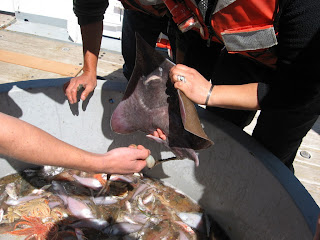


The first and second trawls were both very successful. The net captured a variety of animals ranging from a tiny jellyfish to a medium size skate. Mariah and Shaara, the graduated students at MLML, are doing research on skates. I have taken a couple of short videos on the dissection of the skates that I hope to be able to upload to this blog site soon. Donna, Mariah, and Shaara all helped with identifying the different fish that were measured and dissected.







Tomorrow morning, the respirometer will be recovered and we hope it will come to the surface with fish inside the chambers. Also, the deep-sea camera will be deployed tomorrow. Unfortunately there was a missing cable and the camera was not able to be deployed today. John, the Technician/Research Assistant, was able to make a new cable and solder it together for the camera deployment tomorrow.

Today was a long day with many activities. I look forward to tomorrow morning’s recovery of the respirometer, and trawling for more deep-sea fish.
=)

“This material is based upon work supported by the National Science Foundation under Grant No. 0727135. Any opinions, findings and conclusions or recommendations expressed in this material are those of the author(s) and do not necessarily reflect the views of the National Science Foundation (NSF).”
+062.jpg)
Hi Michelle,
ReplyDeleteWhat is the average temperature of the fish retrieved from the bottom of the sea? Are they cold to touch? Do they have scales or skin like a catfish? How do they breath so far down in the sea?
Mom
Hello, Mom. Here are the answers to your questions. They were all answered by the collaborative effort by the graduate students, Donna, Mariah and Shaara.
ReplyDeleteAt 500 meters we recorded temperature of 6 degrees Celsius. The fish are cold to touch when they surface and some are really slimy. Most of the fishes have scales, but some like the ratfish or hagfish do not have any scales. Whether a fish has scales depends on where it lives in the ocean and if it needs them for protection or locomotion. If a fish needs to be heavily armored, like the poacher, it will possess heavy scales for protection, or if it needs to be agile and produces a lot of slime like the hagfish, it won’t have any at all.
Most fish in deep-sea breathe the same way they do in shallower water, passing water over their gills and out their opercular openings, extracting oxygen from the water as it passes over the gills. Many deep-sea fish are slower and “flabbier” (tissues contains a lot more water with less solid muscle structure) which may decrease their metabolic demands, meaning they don’t have to put as much energy into respiration. This is something that is being investigated on this research cruise with the respirometer.
hey miss.kay
ReplyDeletethat fish that was cut open was so gross but its cool to stay on a boat
wow! That is interesting but kind of nasty!!!
ReplyDeletethe cut fish is cool and gross and somehow interesting
ReplyDeletebut its cool to learn about fish.
wow that was alot of fish
ReplyDeletehi this is daney kuresa
ReplyDeletehey Ms.Kay this is cool that you guy get to fish and research it. Hope you guys have fun and be safe next week! buh-bye!:)
from: Daney Kuresa